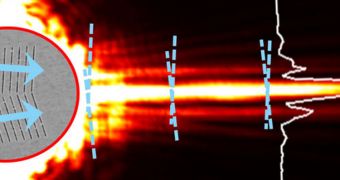Optical system technologies currently used on computer chips are plagued by several issues, the most important of which is signal loss caused by light dispersion. In a new study, an international team of experts proposes a solution, in the form of a “needle beam” of light.
The reason why the light produced by the new technology is referred to as a needle beam is that it exhibits little to no dispersion over a long distance. This achievement has the potential to significantly reduce the amount of signal loss current chips display.
The research group that developed the light beam was coordinated by experts at the Harvard University School of Engineering and Applied Sciences (SEAS), and featured experts from the CNRS Laboratoire Interdisciplinaire Carnot de Bourgogne, in France.
In addition to exhibiting no dispersion, the needle beam is also very narrow, and capable of maintaining these properties over a long distance. In the near future, the team believes, it could lead to the development of a new generation of extremely powerful computer microprocessors.
Full details of how this type of light can be produced were published in the August 31 online issue of the esteemed scientific journal Physical Review Letters. The thing about this beam is that it travels most efficiently at the boundary between gold and air.
A special class of quasiparticles that travel in tight confinement with a metal surface, called surface plasmons, is required in order to produce it. When applied in practice, these beams can replace copper connections inside microprocessors, enabling instantaneous communications.
A prerequisite of creating the beam was to defeat the natural tendency of light waves to interact with each other and spread out laterally, known as diffraction.
“We have made a major step toward solving this problem by discovering and experimentally confirming the existence of a previously overlooked solution of Maxwell's equations that govern all light phenomena,” says Federico Capasso, the principal investigator of the study.
“The solution is a highly localized surface plasmon wave that propagates for a long distance, approximately 80 microns in our experiments, in a straight line without any diffraction,” he adds.
Capasso holds an appointment as the Robert L. Wallace professor of applied physics and Vinton Hayes senior research fellow in electrical engineering at Harvard SEAS.

 14 DAY TRIAL //
14 DAY TRIAL //